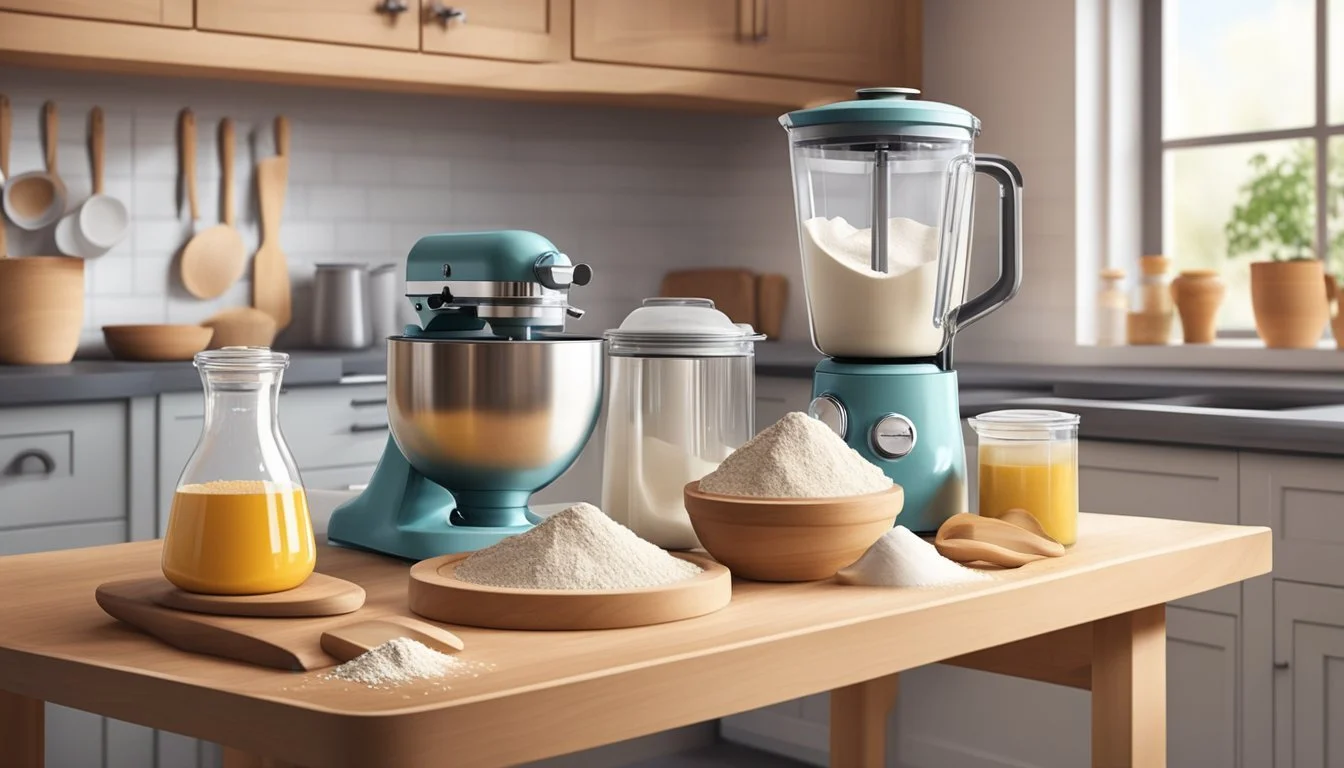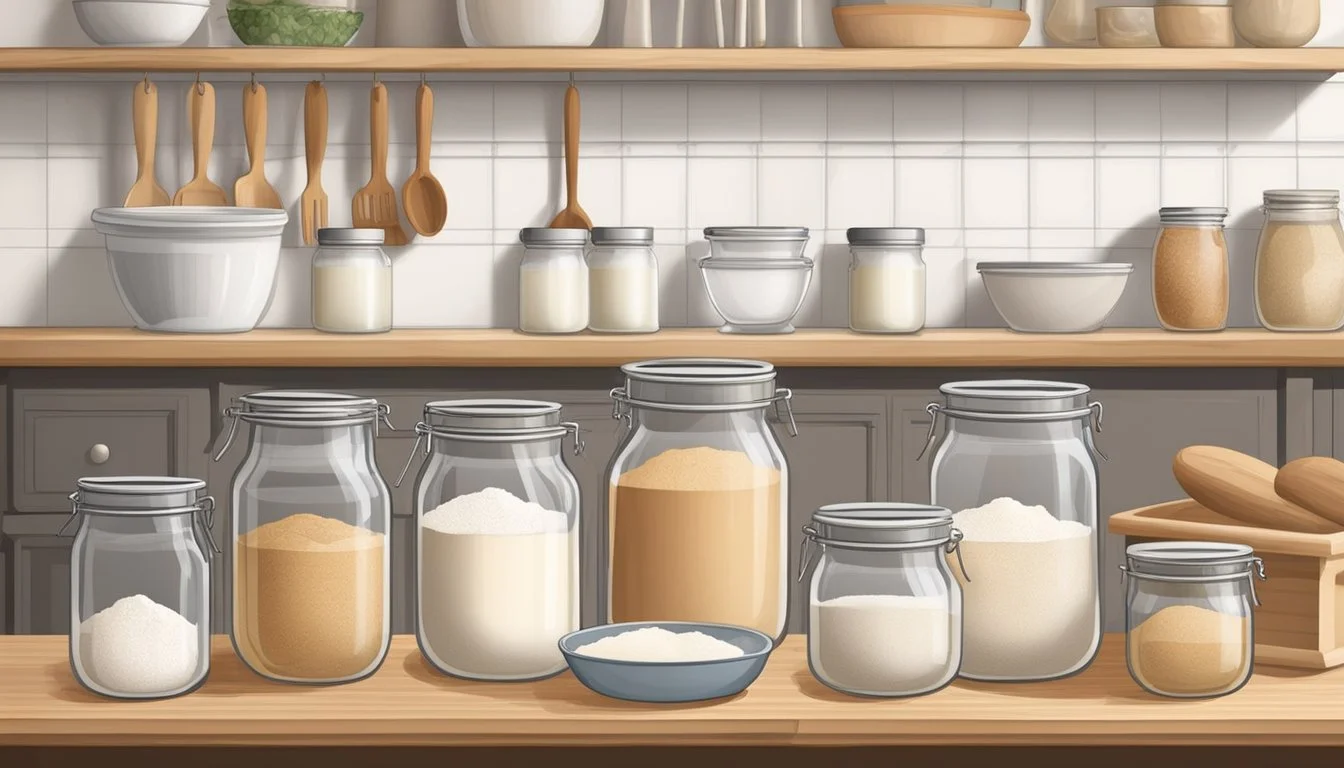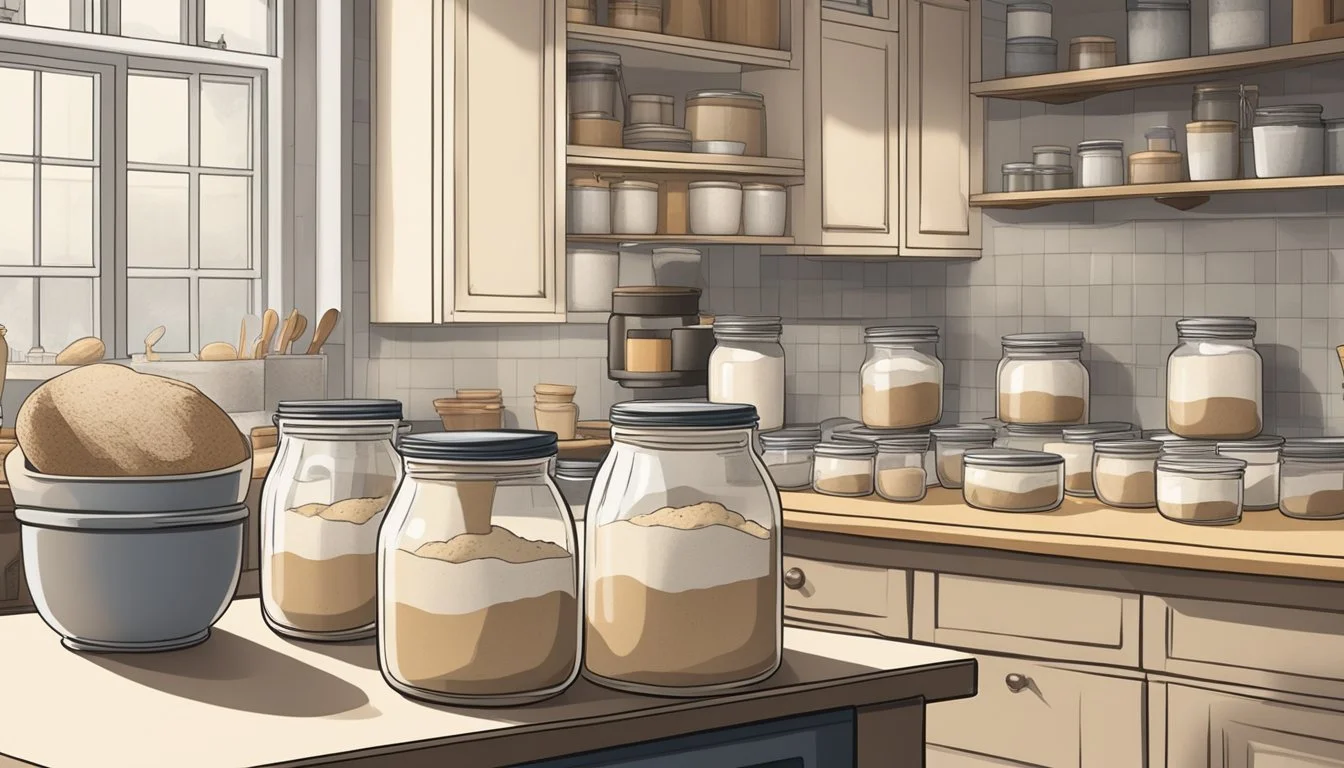How to Create an Organized Kitchen Sourdough Bread Making Station
Essential Tips and Tools
Sourdough bread making is an art that marries tradition with technique, rewarding bakers with rich flavors and a sense of accomplishment. A well-organized kitchen space dedicated to this craft not only streamlines the process but can enhance the overall baking experience. Creating a specialized sourdough station within the kitchen calls for thoughtful organization of tools and ingredients to ensure everything is at hand when the baker's inspiration strikes.
Key to this preparation is the arrangement of ingredients, especially the variety of flours essential to sourdough bread making. A clear, designated area for storing these, along with other staples such as salt and water, facilitates a smoother baking process. Furthermore, having tools like a reliable bread pan, a scale for precise measurements, and storage containers for the all-important sourdough starter contributes to the maintenance of a clean and efficient workspace.
For a baker invested in the nuances of sourdough, the kitchen setup can make a remarkable difference in the outcome of their loaves. Taking steps to ensure the ingredients are fresh, tools are accessible, and the baking environment is well-ordered can turn bread making from a simple task to a culinary adventure, delivering delicious sourdough bread with every bake session.
Understanding Sourdough
Sourdough bread making is an art that marries age-old traditions with scientific principles. An organized kitchen station enhances the precision and enjoyment of this culinary craft.
Sourdough Basics
Sourdough is a method of bread baking that uses a fermented mixture of flour and water, known as a starter, to leaven the dough. This starter cultivates wild yeast and beneficial bacteria that cause the dough to rise naturally without the need for commercial yeast.
Baking Science
The fermentation process is at the heart of sourdough baking, relying on wild yeast and bacteria to convert the sugars in flour into carbon dioxide gas and ethanol. This not only makes the dough rise but also develops complex flavors.
Selecting Ingredients
Quality ingredients are paramount in sourdough baking. Choose a high-protein bread flour for a chewy texture and strong gluten development. All-purpose flour, whole wheat, and rye are also popular choices for creating variations in flavor and color.
The Role of Equipment
Critical tools for sourdough baking include a kitchen scale for precise measurement, a Dutch oven or combo cooker for optimal heat distribution, and a proofing basket (banneton) to shape and support the dough during its final rise. Sharp tools like a lame or razor blade are essential to score the dough just before baking, aiding in the oven spring.
Dough Preparation Techniques
Master techniques like autolyse, which allows flour to fully hydrate before adding salt and starter, and stretch and folds to strengthen the gluten network. Bulk fermentation is a key stage where the dough rises slowly, developing flavor and structure.
Flavor and Texture
Flavor in sourdough is cultivated during the long fermentation process, resulting in a characteristic tangy or tart profile. The texture ranges from chewy to soft, influenced by ingredient ratios, hydration levels, and kneading techniques.
Sourdough Recipes and Formulas
Recipes like the famed Tartine bread highlight the importance of ratios, often referred to as baker's percentages. The Perfect Loaf and Fresh Loaf websites offer new recipes combining traditional methods with modern twists for both family favorites and fresh explorations.
Health and Dietary Considerations
Sourdough is a popular choice for those seeking a healthier alternative to commercial bread. The fermentation process reduces phytates, making nutrients more accessible, and the presence of lactic acid bacteria can aid digestion.
Sourdough Community and History
Sourdough baking is steeped in history and tradition, with each culture having its unique recipes and methods. Today, online communities and forums like The Fresh Loaf connect bakers worldwide, sharing tips, techniques, and sourdough stories.
Troubleshooting Sourdough
Common mistakes in sourdough baking include overproofing, underproofing, and improper scoring. Assessing the dough's progress and making precise adjustments are essential for successful bakes. Tips from experienced bakers can guide beginners through these challenges.
Designing Your Sourdough Station
Creating an organized kitchen sourdough station requires thoughtful consideration of space, efficiency, and the specific needs of sourdough baking. Proper layout and tool organization can transform baking from a chore to a delightful experience.
Evaluating Kitchen Layout
To maximize the potential of a sourdough station, one should assess the existing kitchen layout. Identify sections of the kitchen with ample counter space that can accommodate a large mixing bowl and kneading area. If available, an island can serve as an ideal central baking station, while the proximity of the pantry and kitchen cabinets should be considered for quick access to ingredients and tools.
Selecting the Right Surfaces
The choice of surface for kneading and shaping sourdough is significant. Marble countertops are preferred for their cool temperature, which helps in dough handling. However, a large wooden board or a silicone baking mat can be equally effective. Ensure surfaces are durable and simple to clean to maintain a hygienic baking environment.
Organizing Baking Tools and Ingredients
A well-organized baking station prevents clutter and increases productivity. Use clear, airtight containers to store flour and grains in the pantry. Cabinets and drawers should be equipped with dividers to segregate utensils like wooden spoons, pastry scrapers, and spatulas. Designate a specific baking drawer for smaller tools, and utilize hooks or racks for kitchen towels and bench rests to keep them within arm's reach.
Optimizing for Baking Efficiency
Efficiency in a baking station is achieved through strategic placement and organization. Arrange mixing bowls, measuring cups, and scales in a logical progression following your baking process. Maintenance of the area is critical; thus, incorporate easy-to-clean materials and implement a system for regular cleaning of the baking station after use.
Creating a Baking Schedule
One's sourdough station should include a visible baking schedule to streamline the baking process and manage baking timelines effectively. Posting a calendar or a whiteboard can help one track fermentation times and bake dates, ensuring that the sourdough station is prepped and ready when it's time to begin the next baking session.
Storage Solutions for Ingredients and Tools
Creating a dedicated sourdough bread making station improves efficiency and helps maintain the quality of ingredients and tools. Proper storage solutions ensure that ingredients remain fresh and tools are kept in good condition, making the baking process smoother.
Keeping Sourdough Starter Healthy
To maintain an active sourdough starter, it's essential to store it in a glass or ceramic jar with a loose-fitting lid to allow for air circulation. The starter should be kept at a consistent temperature and fed regularly. If the kitchen is in a dry climate, one might consider covering the jar with a damp kitchen towel to prevent the starter from drying out.
Flour and Dry Ingredient Management
Flours and other dry ingredients should be stored in airtight containers to prevent moisture intrusion and to extend their shelf life. Containers should preferably be opaque to minimize light exposure. Use a dating system to track freshness, with newer bags of King Arthur Flour and other ingredients placed behind older ones. Dusting tools like sieves or shakers should be easily accessible to work with flours.
Tool and Equipment Storage
Essential tools such as a pastry scraper, proofing baskets, and a serrated knife should be organized neatly within reach. Clear storage bins or designated drawers can help in grouping tools according to their use phase—mixing, shaping, or baking. Commonly used items, like measuring cups and spoons, benefit from hanging storage for easy access.
Refrigeration and Freezing
For ingredients requiring cold storage, such as starter that is not in daily use, designate an area in the refrigerator to avoid flavor contamination. Freezing pre-measured flour for later use can also save time—ensure these are labeled correctly and sealed tightly to avoid freezer burn.
Labeling and Rotation Systems
Implement a labeling system for both ingredients and storage containers to track types of flour and baked goods. This not only prevents mix-ups but also helps with rotating stocks based on dating. Regularly check and update labels, especially when refilling containers or bins.
Advanced Sourdough Techniques
Advancing in sourdough baking means exploring a variety of techniques that can influence the flavor, texture, and appearance of bread. This section offers guidance on refining these skills to elevate homemade sourdough bread.
Exploring Different Types of Bread
Experimentation with various grains such as spelt, rye, and whole wheat can introduce a spectrum of flavors and textures. The incorporation of ancient grains into sourdough baking not only diversifies the types of bread but also enhances nutritional value.
Spelt Sourdough: A nutty flavor and a tender crumb.
Rye Sourdough: Dense texture with a deep, earthy taste.
Whole Wheat Sourdough: Rich in flavor with a balanced crumb.
Innovative Sourdough Variations
Adding ingredients such as nuts or dried fruits can create flavored bread that stands out. Flavored sourdough variations invite a creative twist to traditional recipes, often resulting in a delightful interplay of tastes.
Walnut Sourdough: Bold, earthy notes.
Cranberry Sourdough: Tartness complementing the bread's inherent tang.
Mastering Fermentation Control
Achieving consistent flavor development and texture hinges on precise fermentation control. Managing temperature and humidity levels is crucial for optimal yeast activity and bacterial growth, which directly affects the sourdough's taste and rise.
Temperature: A warmer environment accelerates fermentation.
Humidity: Maintains dough hydration level, affecting extensibility and oven spring.
Artisan Scoring and Baking
Scoring creates not only artistic patterns but also directs the bread's expansion in the oven. The use of parchment and a preheated cast iron Dutch oven can simulate professional baking environments, resulting in superior crust and oven spring.
Scoring Designs: Slashes that allow the bread to expand artistically.
Dutch Oven: Traps steam, contributing to a well-developed crust.
Sourdough in Various Climates
Sourdough baking requires adaptation to local climate conditions. Ambient temperature and humidity can impact fermentation and proofing stages, necessitating adjustments to ensure the bread's quality remains unaffected by the surrounding environment.
Cold Climates: Longer fermentation times.
Hot Climates: Increased risk of over-proofing, requiring diligent monitoring.
Aftercare and Maintenance
Aftercare and maintenance of a sourdough bread making station involves detailed cleaning, mindful starter care, diligent tool upkeep, and space organization to ensure an efficient and sanitary kitchen environment.
Cleaning After Baking
Sanitizing Work Surfaces: One must thoroughly clean and sanitize countertops using a food-safe cleaner after baking.
Kitchen Towels: Use separate kitchen towels for drying hands and cleaning countertops; wash them frequently to prevent bacterial buildup.
Sourdough Starter Maintenance
Feeding Routine: Maintain a feeding schedule, typically adding equal parts flour and water to the starter.
Discarding Starter: Regularly discard a portion of the starter to keep it active; this can be daily or weekly, depending on the storage.
Tool Care and Longevity
Utensil Cleaning: Immediately after use, wash utensils with warm soapy water to prevent dough residue from hardening.
Storage: Store baking tools in a dry place to avoid rust and deterioration; consider hanging commonly used tools for easy access.
Kitchen Space Organization
Storage Tips: Label all ingredients and designate specific areas for them to maximize efficiency and maintain order.
Organization: Keep a dedicated station for sourdough preparation that is equipped with all necessary tools and ingredients, ensuring a streamlined baking process.
Joining the Sourdough Community
Joining the sourdough community enriches the baking experience by providing access to a wealth of collective knowledge and opportunities.
Sharing Your Sourdough Journey
A baker might start sharing their sourdough journey on social media platforms and blogging sites. This allows for capturing the progress of one's sourdough bread-making escapades, showcasing successes and seeking advice on challenges. It’s a way of sharing knowledge and experiences with others who appreciate the art of sourdough baking.
Learning from Sourdough Experts
Through online resources and sourdough books, individuals can learn from experienced bakers. Forums and articles are platforms where one can ask questions and receive tips. Learning opportunities abound when one actively seeks advice from those more seasoned in the craft.
Participating in Workshops and Classes
There is great value in participating in workshops and classes. These organized learning settings often provide hands-on experience and direct interaction with skilled instructors. They can be found by searching through local community centers or online platforms that offer sourdough baking classes.
Connecting with Local Bakers
Building relationships with local sourdough bakers provides an opportunity for networking and learning. Visiting local bakeries and participating in community events can lead to the exchange of sourdough resources and techniques.
Contributing to Sourdough Resources
An enthusiastic baker could consider contributing to sourdough resources themselves, perhaps by writing articles, creating tutorials, or even starting a local sourdough club. By doing so, they offer back to the community and help maintain the vibrant cycle of sharing knowledge and resources.
Conclusion
An organized kitchen, with a dedicated sourdough baking station, can greatly enhance the bread-making process. The baker must ensure that their pantry is neatly arranged, with ingredients like flour and grains stored in airtight containers to maintain freshness and deter pests.
A tidily arranged sourdough station should ideally have the following:
A clear jar for the sourdough starter, allowing for easy monitoring of the fermentation process.
A standard set of supplies: scales, measuring spoons, containers, and a thermometer for precision.
Designated storage for bread flour, whole wheat flour, and other frequently used ingredients.
Successful sourdough bread making relies on consistency and attention to detail. Organizing the kitchen workspace empowers the baker to maintain these standards and fosters a more enjoyable baking experience.
Bakers should be encouraged by the prospect of creating delicious sourdough bread in a well-prepared environment. Every component from the initial starter to the finished loaf is a testament to the care and consideration put into the process.
By investing time in creating an efficiently organized sourdough station, they pave the way for a rewarding and possibly even transformative culinary journey.






